Portuguese Empire
The Portuguese Empire (Portuguese: Império Português) was the first global empire in history, with territories in South America, Africa, India and South East Asia. It was also the longest lived of the modern European colonial empires, spanning almost six centuries, from the capture of Ceuta in 1415 to the handover of Macau in 1999.
Portuguese explorers began exploring the coast of Africa in 1419, making use of the latest developments in navigation, cartography and maritime technology such as the caravel, in order that they might find a sea route to the source of the lucrative spice trade. In 1488, Bartolomeu Dias rounded the Cape of Good Hope, and in 1498, Vasco da Gama reached India. In 1500, by an accidental landfall on the South American coast for some, by the crown's secret design for others, Pedro Álvares Cabral would find and lead to the establishment of the colony of Brazil. Over the following decades, Portuguese sailors continued to explore the coasts and islands of East Asia, establishing forts and factories as they went. By 1571, a string of outposts connected Lisbon to Nagasaki: the empire had become truly global, and in the process brought great wealth to Portugal.
Between 1580 and 1640 Portugal became the junior partner to Spain in the union of the two countries' crowns. Though the empires continued to be administered separately, Portuguese colonies became the subject of attacks by three rival European powers hostile to Spain and envious of Iberian successes overseas: The Netherlands (which was engaged in a war of independence against Spain), England and France. With a smaller population, Portugal was unable to effectively defend its overstretched network of trading posts, and so the empire began its long and gradual decline.
With the end of the Portuguese trade monopoly in the Indian Ocean, after significant losses in Portuguese India and Southeast Asia, it turned to Brazil. The loss of Brazil in 1822, by then Portugal's largest and most profitable colony, at a time when independence movements were sweeping the Americas, was a blow from which Portugal and its empire would never recover.
The Scramble for Africa which began in the late 19th century left Portugal with a handful of colonies on the continent. Most of these African territories were under Portuguese administration and influence for centuries. Cities like Luanda and Benguela, and dozens of other settlements, ports and forts, had been founded and ruled by Portugal since the 16th century. After World War II, Portugal's leader, António Salazar, attempted to keep the Portuguese Empire intact at a time when other European countries were beginning to withdraw from their colonies. In 1961 the handful of Portuguese troops garrisoned in Goa were unable to prevent Indian troops marching into the colony. Salazar began a long and bloody war to quell anti-colonialist forces in the African colonies. The unpopular war lasted until the overthrow of the regime in 1974, known as the Carnation Revolution. The new government immediately changed policy and recognised the independence of all its colonies, except for Macau, which by agreeement with the Chinese government was returned to China in 1999, marking the end of the Portuguese overseas empire.
The Community of Portuguese Language Countries (CPLP) is the cultural successor of the Empire.
Origins (1139–1415)

The origins of the Portuguese Empire, and of Portugal itself, lay in the reconquista—the gradual Christian reconquest of the Iberian peninsula from the Moors. After establishing itself as a separate kingdom in 1139, Portugal completed its reconquista by 1249, but its independence continued to be threatened by neighbouring Castile until the signing of the Treaty of Ayllón in 1411. Free from threats to its existence, Portuguese attention turned overseas and towards a military expedition to the Muslim lands of North Africa.[1] There were several probable motives for an attack on the Marinid Sultanate in present-day Morocco. It offered the opportunity to continue the Christian crusade aspect of the reconquista against Islam. To the military class, it promised glory on the battlefield and the spoils of war.[2] It was also a chance to expand Portuguese trade and to address Portugal's economic decline.[1]
In 1415 an attack was made on Ceuta, a strategically located Muslim city at the mouth of the Mediterranean Sea, and one of the terminal ports of the trans-Saharan gold and slave trades. The Battle of Ceuta was a military success, and marked one of the first steps in Portuguese expansion beyond the Iberian Peninsula,[3] but it proved costly to defend against the Muslim forces that soon besieged it. The Portuguese were unable to use it as a base for further expansion into the hinterland,[4] and the trans-Saharan trade routes shifted to use alternative Muslim ports.[5]
Age of discovery (1415–1500)

Although Ceuta proved to be a disappointment for the Portuguese, the decision was taken to hold it while exploring along the Atlantic African coast.[5] A key supporter of this policy was Prince Henry the Navigator, who had been involved in the capture of Ceuta, and who took the lead role in encouraging Portuguese maritime exploration until his death in 1460.[6] At the time, Europeans did not know what lay beyond Cape Bojador on the African coast. Henry wished to know how far the Muslim territories in Africa extended, and whether it was possible to reach Asia by sea, both to reach the source of the lucrative spice trade and perhaps to join forces with the long-lost Christian kingdom of Prester John that was rumoured to exist somewhere in the "Indies".[2][7]
In 1419 two of Henry's captains, João Gonçalves Zarco and Tristão Vaz Teixeira were driven by a storm to Madeira, an uninhabited island off the coast of Africa which had probably been known to Europeans since the 14th century. In 1420 Zarco and Teixeira returned with Bartolomeu Perestrelo and began Portuguese settlement of the islands. A Portuguese attempt to capture Grand Canary, one of the nearby Canary Islands, which had been partially settled by Spaniards in 1402 was unsuccessful and met with protestations from Castile.[8] Although the exact details are uncertain, cartographic evidence suggests the Azores were probably discovered in 1427 by Portuguese ships sailing under Henry's direction, and settled in 1432, suggesting that the Portuguese were able to navigate at least Template:Mi to km from the Portuguese coast.[9]
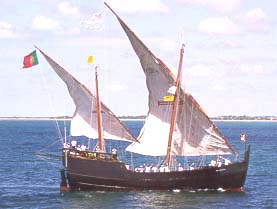
At around the same time as the unsuccessful attack on the Canary Islands, the Portuguese began to explore the North African coast. Sailors' fears of what lay beyond Cape Bojador, and whether it was possible to return once it was passed, were finally conquered in 1434 by one of Prince Henry's captains, Gil Eanes. Once this psychological barrier had been crossed, it became easier to probe further along the coast.[10] Henry suffered a serious setback in 1437 after the failure of an expedition to capture Tangier, having encouraged his brother, King Edward, to mount an overland attack from Ceuta. The Portuguese army was defeated and only escaped destruction by surrendering Prince Ferdinand, the king's youngest brother.[11] After the defeat at Tangier, Henry retired to Sagres on the southern tip of Portugal where he continued to direct Portuguese exploration until his death in 1460. In 1443 Prince Pedro, Henry's brother, granted him the monopoly of navigation, war and trade in the lands south of Cape Bojador. Later this monopoly would be enforced by the Bulls Dum Diversas (1452) and Romanus Pontifex (1455), laying the basis for the Portuguese empire.
A major advance which accelerated this project was the introduction of the caravel in the mid-15th century, a ship that could be sailed closer to the wind than any other in operation in Europe at the time.[12] Using this new maritime technology, Portuguese navigators reached ever more southerly latitudes, advancing at an average rate of one degree a year.[13] Senegal and Cape Verde Peninsula were reached in 1445. In 1446, António Fernandes pushed on almost as far as present-day Sierra Leone. The Gulf of Guinea was reached in the 1460s, the Equator in 1473 and the Congo River by Diogo Cão in 1482. In 1486, Cão continued to Cape Cross, in present-day Namibia, near the Tropic of Capricorn. In 1488, Bartolomeu Dias rounded the Cape of Good Hope on the southern tip of Africa, proving false the view that had existed since Ptolemy that the Indian Ocean was land-locked, and suggesting that a sea route to the Indies would soon be forthcoming.[14]
As the Portuguese explored the coastlines of Africa, they left behind a series of padrões, stone crosses enscribed with the Portuguese coat of arms marking their claims,[15] and built forts and trading posts, such as at Arguim (1449) and São Jorge da Mina (1482). From these bases, the Portuguese engaged profitably in the slave and gold trades. Portugal enjoyed a virtual monopoly on the African seaborne slave trade for over a century, importing around 800 slaves annually. Most were brought to the Portuguese capital Lisbon, where it is estimated black Africans came to constitute 10 per cent of the population.[16]
Division of the world (1492–1580)

In 1492 Christopher Columbus's discovery for Spain of the New World, which he believed to be Asia, led to disputes between the Spanish and Portuguese. These were eventually settled by the Treaty of Tordesillas in 1494 which divided the world outside of Europe in an exclusive duopoly between the Portuguese and the Spanish, along a north-south meridian 370 leagues, or Template:Mi to km, west of the Cape Verde islands. However, as it was not possible at the time to correctly measure longitude, the exact boundary was disputed by the two countries until 1777.[17]
The completion of these negotiations with Spain is one of several reasons proposed by historians for why it took nine years for the Portuguese to follow up on Dias's voyage to the Cape of Good Hope, though it has also been speculated that other voyages were in fact taking place in secret during this time.[18][19] Whether or not this was the case, the long-standing Portuguese goal of finding a sea route to Asia was finally achieved in a ground-breaking voyage commanded by Vasco da Gama. The squadron left Portugal in 1497, rounded the Cape and continued along the coast of East Africa, where a local pilot was brought on board who guided them across the Indian Ocean, reaching Calicut in western India in May 1498.[20]

Another voyage to India was dispatched in 1500 under Pedro Álvares Cabral. While following the same south-westerly route as da Gama across the Atlantic Ocean, Cabral made landfall on the Brazilian coast. This was probably an accidental discovery, but it has been speculated that the Portuguese secretly knew of Brazil's existence and that it lay on their side of the Tordesillas line.[21] Cabral recommended to the Portuguese King that the land be settled, and two follow up voyages were sent in 1501 and 1503. The land was found to be abundant in pau-brasil, or brazilwood, from which it later inherited its name, but the failure to find gold or silver meant that for the time being Portuguese efforts were concentrated on India.[22]
In East Africa, small Islamic states along the coast of Mozambique, Kilwa, Brava, Sofala and Mombasa were destroyed, or became either subjects or allies of Portugal. Pêro da Covilhã had reached Ethiopia, travelling secretly overland, as early as 1490; a diplomatic mission reached the ruler of that nation on October 19, 1520. In the Arabian Sea, Socotra was occupied in 1506, and in the same year Lourenço d'Almeida visited Ceylon(Modern day Sri Lanka)(see Portuguese Ceylon). Ormuz, after the failed conquest of 1510, was captured in 1515. Aden, however, resisted Afonso de Albuquerque's expedition in that same year, and another attempt by Albuquerque's successor Lopo Soares de Albergaria in 1516. In the Indian Ocean, one of Pedro Álvares Cabral's ships discovered Madagascar, which was partly explored by Tristão da Cunha in 1507, the same year Mauritius was discovered. In 1509, the Portuguese won the sea Battle of Diu against the combined forces of the Ottoman Sultan Beyazid II, Sultan of Gujarat, Mamlûk Sultan of Cairo, Samoothiri Raja of Kozhikode, Venetian Republic, and Ragusan Republic (Dubrovnik). A second Battle of Diu in 1538 finally ended Ottoman ambitions in India and confirmed Portuguese hegemony in the Indian Ocean.

Portugal established trading ports at far-flung locations like Goa, Ormuz, Malacca, Kochi, the Maluku Islands, Macau, and Nagasaki. Guarding its trade from both European and Asian competitors, Portugal dominated not only the trade between Asia and Europe, but also much of the trade between different regions of Asia, such as India, Indonesia, China, and Japan. Jesuit missionaries, such as the Basque Francis Xavier, followed the Portuguese to spread Roman Catholic Christianity to Asia with mixed success.
The Portuguese empire expanded from the Indian Ocean into the Persian Gulf as Portugal contested control of the spice trade with the Ottoman Empire. In 1515, Afonso de Albuquerque conquered the Huwala state of Hormuz at the head of the Gulf, establishing it as a vassal state, before capturing Bahrain in 1521, when a force led by Antonio Correia defeated the Jabrid King, Muqrin ibn Zamil.[23] In a shifting series of alliances, the Portuguese dominated much of the southern Gulf for the next hundred years.
In 1503, an expedition under the command of Gonçalo Coelho found the French making incursions on the land that is today Brazil. John III, in 1530, organized the colonization of Brazil around 15 capitanias hereditárias ("hereditary captainships"), that were given to anyone who wanted to administer and explore them. That same year, there was a new expedition from Martim Afonso de Sousa with orders to patrol the whole Brazilian coast, banish the French, and create the first colonial towns: São Vicente on the coast, and São Paulo on the border of the altiplane. From the 15 original captainships, only two, Pernambuco and São Vicente, prospered. With permanent settlement came the establishment of the sugar cane industry and its intensive labor demands which were met with Native American and later African slaves. Deeming the capitanias system ineffective, Tomé de Sousa, the first Governor-General was sent to Brazil in 1549. He built the capital of Brazil, Salvador at the Bay of All Saints. The first Jesuits arrived the same year.
From 1565 through 1567 Mem de Sá, a Portuguese colonial official and the third Governor General of Brazil, successfully destroyed a ten year-old French colony called France Antarctique, at Guanabara Bay. He and his nephew, Estácio de Sá, then founded the city of Rio de Janeiro in March 1567.
Iberian rivalry with the Dutch (1580–1663)
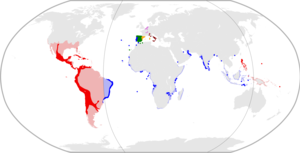

In 1580, King Philip II of Spain invaded Portugal after a crisis of succession brought about by King Sebastian of Portugal's death during a disastrous Portuguese attack on Morocco in 1578. At the Cortes of Tomar in 1581, Philip was crowned Philip I of Portugal, uniting the two crowns and overseas empires under Spanish Habsburg rule in a dynastic Iberian Union. At Tomar Philip promised to keep the empires legally distinct, leaving the administration of the Portuguese Empire to Portuguese nationals, with a Spanish viceroy in Lisbon seeing to his interests.[24] All the Portuguese colonies accepted the new state of affairs except for the Azores, which held out for António, a Portuguese rival claimant to the throne who had garnered the support of Catherine de Medici of France in exchange for the promise to cede Brazil. Spanish forces eventually captured the island in 1583.[25]
The union with Spain entailed both benefits and drawbacks as far as the Portuguese Empire was concerned. Spanish imperial trade networks were opened to Portuguese merchants, which was particularly lucrative for Portuguese slave traders who could now sell slaves in Spanish America at a higher price than could be fetched in Brazil.[26] The Tordesillas line demarcating the boundary between Spanish and Portuguese control in South America was increasingly ignored by the Portuguese, who pressed beyond it into the heart of Brazil.[24] However, the union meant that Spain dragged Portugal into its conflicts with England, France and the Dutch Republic, countries which were beginning to establish their own overseas empires.[27] The primary threat came from the Dutch, who had been engaged in a struggle for independence against Spain since 1568. The Dutch took their fight overseas, attacking Spanish and Portuguese colonies and shipping. The Portuguese Empire, consisting primarily of exposed coastal settlements vulnerable to being picked off one by one, proved to be an easier target than the Spanish Empire.[28]
The Dutch–Portuguese War began with an attack on São Tomé and Príncipe in 1597 and lasted until 1663. The war was waged by the Dutch East India Company (established in 1602) and its West India counterpart (1621), commercial ventures whose aim was to take over the trade networks that the Portuguese had established in Asian spices, West African slaves and Brazilian sugar[29] In Asia, the Dutch captured the Spice Islands (1605), Malacca (1641), Colombo (1656), Ceylon (1658), Nagappattinam (1660), Cranganore and Cochin (1662).[30] Although Goa, the capital of Portuguese Asia,
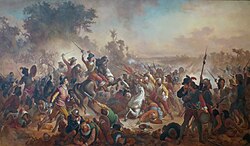
Diu and Macau were successfully defended, the expulsion of the Portuguese from Japan in 1639 excluded Portuguese merchants from the highly profitable China-Japan trade. Having successfully prevented the French from gaining a foothold in Portuguese Brazil at France Équinoxiale in 1615, Salvador da Bahia was lost to the Dutch in 1624 (though recaptured by a joint Spanish-Portuguese force the following year) and Pernambuco in 1630. In need of slaves for the sugar producing regions they had captured in Brazil, the Dutch began attacks on the Portuguese trading posts on the west coast of Africa, successfully taking Elmina (1638), Luanda (1641) and Axim (1642).[31] By 1654, Portugal had succeeded in expelling the Dutch from Brazil and Luanda, though its preeminent position in Asia had been lost forever.
Imperial decline (1663–1822)

The loss of colonies was one of the reasons that contributed to the end of the personal union with Spain. In 1640 John IV was proclaimed King of Portugal and the Portuguese Restoration War began. In 1668 Spain recognized the end of the Iberian Union and in exchange Portugal ceded Ceuta to the Spanish crown.
In 1661 the Portuguese offered Bombay and Tangier to England as part of a dowry, and over the next hundred years the British gradually became the dominant trader in India, providing the bases from which its empire would grow as the Moghul Empire disintegrated from the middle of the 18th century, gradually excluding the trade of other powers in the later 18th and early 19th centuries. Portugal was able to cling onto Goa and several minor bases through the remainder of the colonial period, but their importance declined as trade was diverted through increasing numbers of English, Dutch and French trading posts.
In 1755 Lisbon suffered a catastrophic earthquake, which together with a subsequent tsunami killed more than 100,000 people out of a population of 275,000. This sharply checked Portuguese colonial ambitions in the late 18th century.
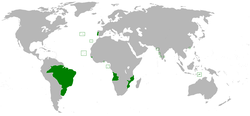
Unlike Spain, Portugal did not divide its colonial territory in America. The captaincies created there were subordinated to a centralized administration in Salvador which reported directly to the Crown in Lisbon.
Encouraged by the example of the United States of America, which had won its independence from Britain, an attempt was made in 1789 to achieve the same in Brazil. The Inconfidência Mineira failed, the leaders arrested and, of the participants of the insurrections the one of lowest social position, Tiradentes, was hanged.
In 1808, Napoleon Bonaparte invaded Portugal, and Dom João, Prince Regent in place of his mother, Dona Maria I, ordered the transfer of the royal court to Brazil. In 1815 Brazil was elevated to the status of Kingdom, the Portuguese state officially becoming the United Kingdom of Portugal, Brazil and the Algarves (Reino Unido de Portugal, Brasil e Algarves), and the capital was transferred from Lisbon to Rio de Janeiro, the only instance of a European country being ruled from one of its colonies. There was also the election of Brazilian representatives to the Cortes Constitucionais Portuguesas (Portuguese Constitutional Courts).
Although the royal family returned to Portugal in 1821, the interlude led to a growing desire for independence amongst Brazilians. In 1822, the son of Dom João VI, then prince-regent Dom Pedro I, proclaimed the independence, September 7, 1822, and was crowned emperor. Unlike the Spanish colonies of South America, Brazil's independence was achieved without significant bloodshed.
Portuguese Africa and the overseas provinces (1822–1961)

At the height of European colonialism in the 19th century, Portugal had lost its territory in South America and all but a few bases in Asia. During this phase, Portuguese colonialism focused on expanding its outposts in Africa into nation-sized territories to compete with other European powers there. Portuguese territories eventually included the modern nations of Cape Verde, São Tomé and Príncipe, Guinea-Bissau, Angola, and Mozambique.
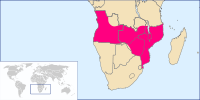
Portugal pressed into the hinterland of Angola and Mozambique, and explorers Serpa Pinto, Hermenegildo Capelo and Roberto Ivens were among the first Europeans to cross Africa west to east. The project to connect the two colonies, the Pink Map, was the Portuguese main objective in the second half of the 19th century. However, the idea was unacceptable to the British, who had their own aspirations of contiguous British territory running from Cairo to Cape Town. The British Ultimatum of 1890 was imposed upon King Carlos I of Portugal and the Pink Map came to an end. The King's reaction to the ultimatum was exploited by republicans. In 1908 King Carlos and Prince Luís Filipe were murdered in Lisbon. Luís Filipe's brother, Manuel, become King Manuel II of Portugal. Two years later Portugal became a republic.
In World War I German troops threatened Mozambique, and Portugal entered the war to protect its colonies.
António de Oliveira Salazar, who took power in 1933, considered Portuguese colonies as overseas provinces of Portugal. In the wake of World War II, the decolonization movements began to gain momentum. In the Portuguese Empire the first major clash occurred in São Tomé in the Batepá massacre of 1953. The Cold War also created instabilities among Portuguese overseas populations, as the United States and Soviet Union tried to increase their spheres of influence. In 1954 India invaded Dadra and Nagar Haveli, and in 1961 Portuguese India came to an end when Goa, Daman and Diu were also invaded. [1] [2] Also in 1961 the tiny Portuguese fort of São João Baptista de Ajudá in Ouidah, a remnant of the West African slave trade, was taken by the new government of Dahomey (now Benin).
But, despite these losses and unlike the other European colonial powers, Salazar attempted to resist the tide of decolonization and maintain the integrity of the empire. As a result, Portugal was the last nation to retain its major colonies.
End of empire (1961–1999)

The rise of Soviet influence among the Movimento das Forças Armadas's military (MFA) and working class, and the cost and unpopularity of the Portuguese Colonial War (1961–1974), in which Portugal resisted to the emerging nationalist guerrilla movements in some of its African territories, eventually led to the collapse of the Estado Novo regime in 1974. Known as the "Carnation Revolution", one of the first acts of the MFA-led government which then came into power - the National Salvation Junta (Junta de Salvação Nacional) - was to end the wars and negotiate Portuguese withdrawal from its African colonies. These events prompted a mass exodus of Portuguese citizens from Portugal's African territories (mostly from Angola and Mozambique), creating over a million Portuguese refugees - the retornados.[32] Portugal's new ruling authorities also recognized Goa and other Portuguese India's territories invaded by India's military forces, as Indian territories. Benin's claims over São João Baptista de Ajudá, were also accepted by the Portuguese, and diplomatic relations were restored with both India and Benin.
Civil wars in both independent Mozambique and Angola promptly broke out, with incoming communist governments formed by the former rebels (and backed by the Soviet Union, Cuba, and other communist countries) fighting against insurgent groups supported by nations like Zaire, South Africa, and the United States.
East Timor also declared independence at this time (1975), making an exodus of many Portuguese refugees to Portugal, also known as retornados. But was almost immediately invaded by neighbouring Indonesia, which occupied it until 1999. A United Nations-sponsored referendum that year resulted in East Timorese choosing independence, which was achieved in 2002.
The transfer of the sovereignty of Macau to China on December 20, 1999 under the terms of an agreement negotiated between People's Republic of China and Portugal twelve years earlier marked the end of the Portuguese overseas empire.
Legacy

The seven former colonies of Portugal that are now independent nations with Portuguese as their official language, together with Portugal, are members of the Community of Portuguese Language Countries. Today Portuguese is one of the world's major languages, ranked 6th according to number of native speakers (between 177 and 191 million). It is the language of about half of South America, even though Brazil is the only Portuguese-speaking nation in the Americas. It is also a major lingua franca in Portugal's former colonial possessions in Africa. It is an official language in eight countries, also being co-official with Cantonese Chinese in the Chinese special administrative region of Macau.
A legacy of Portuguese intermarriage in Malacca during its time as a Portuguese settlement is the Kristang people.
See also
- Portugal
- Kingdom of Portugal
- Economic history of Portugal
- Global empire
- Evolution of the Portuguese Empire
- Portuguese India
- Portuguese West Africa
- Portuguese East Africa
- Colonial Brazil
- United Kingdom of Portugal, Brazil and the Algarves
- Bahrain as a Portuguese dominion
- History of Portugal
- Timeline of Portuguese history
- Portuguese people
- Portuguese language
- Japanese words of Portuguese origin
- Civilising mission
- Lusotropicalism
- Lusosphere
Notes
- ^ a b Newitt, p. 19
- ^ a b Boxer, p. 19
- ^ Abernethy, p. 4
- ^ Newitt, p. 21
- ^ a b Diffie, p. 55
- ^ Diffie, p. 56
- ^ Anderson, p. 50
- ^ Diffie, p. 57–58
- ^ Diffie, p. 60
- ^ Diffie, p. 68
- ^ Anderson, p. 44
- ^ Boxer, p. 29
- ^ Russell-Wood, p. 9
- ^ Anderson, p. 59
- ^ Newitt, p. 47
- ^ Anderson, p. 55
- ^ Diffie, p. 174
- ^ Diffie, p. 176
- ^ Boxer, p. 36
- ^ Scammell, p. 13
- ^ McAlister, p. 75
- ^ McAlister, p. 76
- ^ Juan Cole, Sacred Space and Holy War, IB Tauris, 2007 p37
- ^ a b Boyajian, p. 11
- ^ Anderson, pp. 104–105
- ^ Lockhart, p. 250
- ^ Anderson, p. 105
- ^ Boxer1969, p. 109
- ^ Boxer1969, p. 110
- ^ RussellWood, p. 24
- ^ Davies, p. 124
- ^ Dismantling the Portuguese Empire, Time Magazine (Monday, July 7, 1975)
References
- Abernethy, David (2000). The Dynamics of Global Dominance, European Overseas Empires 1415–1980. Yale University Press. ISBN 0300093144.
- Anderson, James Maxwell (2000). The History of Portugal. Greenwood Publishing Group. ISBN 0313311064.
- Boxer, Charles Ralph (1969). The Portuguese Seaborne Empire 1415–1825. Hutchinson. ISBN 0091310717.
- Boyajian, James (2008). Portuguese Trade in Asia Under the Habsburgs, 1580–1640. JHU Press. ISBN 0801887542.
- Davies, Kenneth Gordon (1974). The North Atlantic World in the Seventeenth Century. University of Minnesota Press. ISBN 0816607133.
- Diffie, Bailey (1977). Foundations of the Portuguese Empire, 1415–1580. University of Minnesota Press. ISBN 0816607826.
- Lockhart, James (1983). Early Latin America: A History of Colonial Spanish America and Brazil. Cambridge University Press. ISBN 0521299292.
- McAlister, Lyle (1984). Spain and Portugal in the New World, 1492–1700. University of Minnesota Press. ISBN 0816612161.
- Newitt, Malyn D.D. (2005). A History of Portuguese Overseas Expansion, 1400–1668. Routledge. ISBN 0415239796.
- Russell-Wood, A.J.R. (1998). The Portuguese Empire 1415–1808. John Hopkins University Press. ISBN 0801859557.
- Scammell, Geoffrey Vaughn (1997). The First Imperial Age, European Overseas Expansion c.1400–1715. Routledge. ISBN 0415090857.
External links
- Portuguese Empire Timeline
- Japanese Screen Painting of the Portuguese in the Indies (Enlarge)
- Dutch Portuguese Colonial History Dutch Portuguese Colonial History: history of the Portuguese and the Dutch in Ceylon, India, Malacca, Bengal, Formosa, Africa, Brazil. Language Heritage, lists of remains, maps.
- The Portuguese and the East (in Portuguese, Chinese, Japanese and Thai) with English introduction.
- Sizes of the largest Empires in History:"To Rule the Earth"
- The First Global Village by Martin Page



